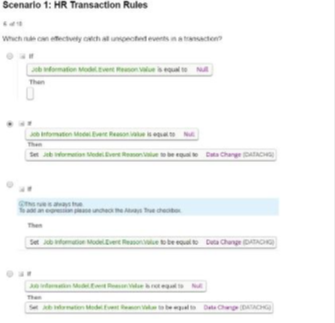At ValidExamDumps, we consistently monitor updates to the SAP C_THR81_2411 exam questions by SAP. Whenever our team identifies changes in the exam questions,exam objectives, exam focus areas or in exam requirements, We immediately update our exam questions for both PDF and online practice exams. This commitment ensures our customers always have access to the most current and accurate questions. By preparing with these actual questions, our customers can successfully pass the SAP Certified Associate - Implementation Consultant - SAP SuccessFactors Employee Central Core Exam exam on their first attempt without needing additional materials or study guides.
Other certification materials providers often include outdated or removed questions by SAP in their SAP C_THR81_2411 exam. These outdated questions lead to customers failing their SAP Certified Associate - Implementation Consultant - SAP SuccessFactors Employee Central Core Exam exam. In contrast, we ensure our questions bank includes only precise and up-to-date questions, guaranteeing their presence in your actual exam. Our main priority is your success in the SAP C_THR81_2411 exam, not profiting from selling obsolete exam questions in PDF or Online Practice Test.
The employee is changing their marital status. Once the workflow is approved, the manager gets a notification via e-mail that this change has been processed. The manager then goes into the system and checks the workflow, but notices that they can see more fields than the ones for which they should receive a notification (Name, Marital Status, and Nationality)
Why is that?
When the manager can view more fields than they should, it is typically because in the workflow configuration, the Respect Permissions setting for the notification line to the manager was set to No. This means that the system does not enforce field-level permissions when the manager views the workflow.
Scenario 2: Approvals for Self-Service
Manager A initiated a job code change for Employee X with an effectivity date of January 15. Another manager initiated the same request, but for January 30. What happens to the workflows triggered by both transactions?
When two workflows are initiated for the same employee with different effective dates, both workflows are allowed to proceed independently. The system processes them sequentially based on their respective effective dates. This ensures that updates are recorded in the order they occur without rejecting either workflow.
Other options, such as canceling or rejecting workflows, do not align with standard system behavior for managing multiple transactions.
Which rule can effectively catch all unspecified events in a transaction?

The rule in Option B effectively captures all unspecified events in a transaction because:
It sets the Event Reason Value to 'Data Change' whenever the Event Reason Value is null.
This ensures that all unplanned or unspecified events are assigned a default action, which is crucial for maintaining data consistency and avoiding errors during transactions.
Scenario 1: HR Transaction Rules
What must be done to ensure that you can use a custom generic (MDF) object for Employee Self- Service? Note: There are 2 correct answers to this question.
To enable a custom Generic (MDF) object for Employee Self-Service (ESS) in SAP SuccessFactors Employee Central, the following configurations are necessary:
C . Create one configuration UI for the object.
A Configuration UI (User Interface) must be created for the MDF object to define how users will interact with it. This UI facilitates data entry and management within the ESS framework.
D . Set the externalCode field to Data Type = User.
The externalCode field should be set to the 'User' data type. This configuration ensures that the object is associated with specific user records, enabling personalized data management within ESS.
Options A and B are not required for enabling a custom MDF object for Employee Self-Service:
A . Set the externalName field to Data Type = User.
The externalName field typically holds descriptive information and does not need to be set to the 'User' data type for ESS functionality.
B . Create a Valid When association for the object.
While associations can define relationships between objects, a 'Valid When' association is not a prerequisite for enabling ESS capabilities for a custom MDF object.
A customer needs to create a custom field that appears only for legal entity France. How do you create the required field?
To create a custom field that appears only for legal entity France:
Use Configure Object Definition to add the field in the Legal Entity object.
Add field criteria to display the field conditionally based on the country being France.
This approach allows you to manage country-specific fields without modifying the Corporate Data Model directly.